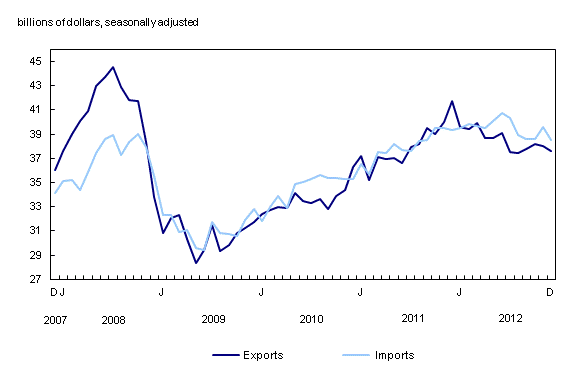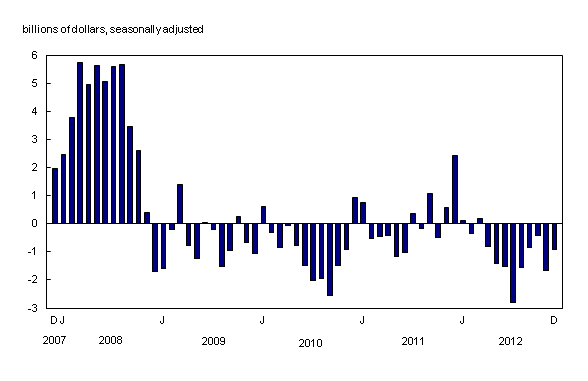Canadian international merchandise trade, December 2012
Archived Content
Information identified as archived is provided for reference, research or recordkeeping purposes. It is not subject to the Government of Canada Web Standards and has not been altered or updated since it was archived. Please "contact us" to request a format other than those available.
Related subjects
-
[an error occurred while processing this directive]
Canada's merchandise imports fell 2.8% in December and merchandise exports declined 0.9%. As a result, Canada's trade deficit with the world decreased from $1.7 billion in November to $901 million in December.
Exports and imports

Chart description: Exports and imports
Volumes largely accounted for the declines in imports and exports.
Imports fell to $38.5 billion, as volumes decreased 2.7%. Imports were down in most sections with the largest decrease in basic and industrial chemical, plastic and rubber products.
Exports declined to $37.6 billion as volumes fell 2.1%, while prices rose 1.2%. Decreases in exports of energy products as well as motor vehicles and parts were partly offset by an increase in metal ores and non-metallic minerals.
Exports to the United States fell 4.0% to $27.6 billion, mainly on lower exports of motor vehicles and parts. Imports from the United States decreased 3.3% to $24.1 billion. Consequently, Canada's trade surplus with the United States narrowed from $3.8 billion in November to $3.5 billion in December.
Exports to countries other than the United States rose 8.5% to $10.0 billion while imports declined 2.0% to $14.5 billion. As a result, Canada's trade deficit with countries other than the United States decreased from $5.5 billion in November to $4.4 billion in December.
Widespread declines in import volumes
Imports of basic and industrial chemical, plastic and rubber products fell 9.7% to $2.9 billion in December, as widespread declines in volumes occurred throughout the section. The main contributor to the overall decrease was imports of lubricants and other petroleum refinery products, which fell 43.8% on lower volumes.
Imports of motor vehicles and parts declined 3.9% to $6.6 billion, as the holiday season plant shutdowns were longer than in previous years. Motor vehicle engines and motor vehicle parts fell 8.6% to $2.7 billion, the largest decrease in the section, as volumes declined 8.0%.
Imports of industrial machinery, equipment and parts decreased 6.8% to $3.4 billion as volumes were down 6.5%. Contributing the most to the decline were imports of logging, mining and construction machinery, which fell 18.9%. This was the sixth consecutive monthly decrease for this group following a record high in June.
Metal ores and non-metallic minerals fell 19.0% to $786 million in December, after three consecutive monthly increases. This decline was led by a 20.5% decrease in imports of metal ores and concentrates, primarily lead and zinc ores and concentrates. Overall, volumes of metal ores and non-metallic minerals declined 18.0%.
An increase in volumes and prices pushed imports of energy products up 5.1% to $3.8 billion. Crude oil and crude bitumen was the main contributor to the gain, rising 7.4% to $2.6 billion.
Energy products leads decline in exports
Following four consecutive monthly increases, exports of energy products fell 6.9% to $8.0 billion in December as volumes fell 10.0%. Overall, the main contributor to the decline was crude oil and crude bitumen, followed by natural gas, and other energy products, primarily coal.
Exports of motor vehicles and parts decreased 6.8% to $5.6 billion, largely the result of lower volumes. Exports of passenger cars and light trucks, which fell 10.5% to $3.8 billion, accounted for the majority of the decrease.
Exports of metal ores and non-metallic minerals rose 26.3% to $1.7 billion. Leading the gain were exports of copper ores and concentrates, as well as potash, the result of higher volumes.
Metal and non-metallic mineral products increased 7.7% to $4.6 billion. Gains were widespread throughout the section. Exports of unwrought precious metals and precious metal alloys rose 15.3% to $1.5 billion on higher volumes.
Trade balance

Chart description: Trade balance
Note to readers
Merchandise trade is one component of Canada's international balance of payments (BOP), which also includes trade in services, investment income, current transfers as well as capital and financial flows.
International merchandise trade data by country are available on both a BOP and a customs basis for the United States, Japan and the United Kingdom. Trade data for all other individual countries are available on a customs basis only. BOP data are derived from customs data by making adjustments for factors such as valuation, coverage, timing and residency. These adjustments are made to conform to the concepts and definitions of the Canadian System of National Accounts.
Data in this release are on a BOP basis, seasonally adjusted and in current dollars. Constant dollars are calculated using the Laspeyres volume formula (2007=100).
For more information on seasonal adjustment, see Seasonal adjustment and identifying economic trends.
Beginning with the release of the January 2013 reference month, the Canadian international merchandise trade data will be made available on average 35 days after the end of the reference month, 5 days earlier than previously. For further information, consult the release date calendar.
Revisions
In general, merchandise trade data are revised on an ongoing basis for each month of the current year. Current year revisions are reflected in both the customs and BOP based data.
The previous year's customs data are revised with the release of the January and February reference months as well as on a quarterly basis. The previous two years of customs based data are revised annually and are released in February with the December reference month.
The previous year's BOP based data are revised with the release of the January, February and March reference months. Revisions to BOP based data for the previous three years are released annually in June with the April reference month.
Factors influencing revisions include late receipt of import and export documentation, incorrect information on customs forms, replacement of estimates produced for the energy section with actual figures, changes in classification of merchandise based on more current information, and changes to seasonal adjustment factors.
Revised data are available in the appropriate CANSIM tables.
Available in CANSIM: tables CANSIM table228-0058 to 228-0068.
Definitions, data sources and methods: survey numbers survey number2201, survey number2202 and survey number2203.
These data are available in the Canadian International Merchandise Trade Database (Catalogue number65F0013X), is also available from the Browse by key resource module of our website under Publications.
The December 2012 issue of Canadian International Merchandise Trade, Vol. 66, no. 12 (Catalogue number65-001-X), is also available from the Browse by key resource module of our website under Publications.
Current account data (which incorporate merchandise trade statistics, service transactions, investment income and transfers) are available quarterly in Canada's Balance of International Payments (Catalogue number67-001-X).
Data on Canadian international merchandise trade for January will be released on March 7.
For more information, contact us (toll-free 1-800-263-1136; infostats@statcan.gc.ca).
To enquire about the concepts, methods or data quality of this release, contact Anne Couillard (613-951-6867), International Trade Division.
- Date modified:
